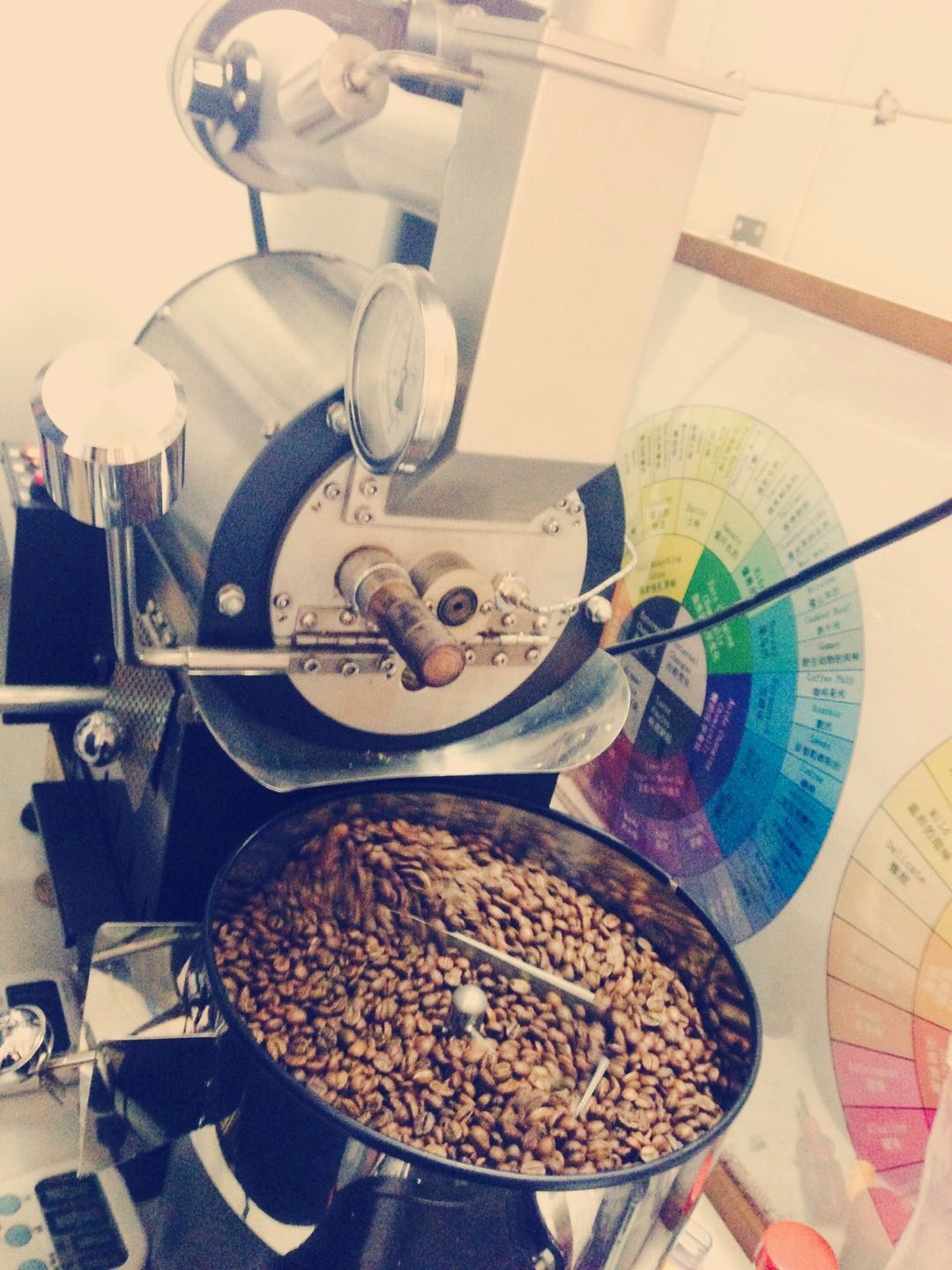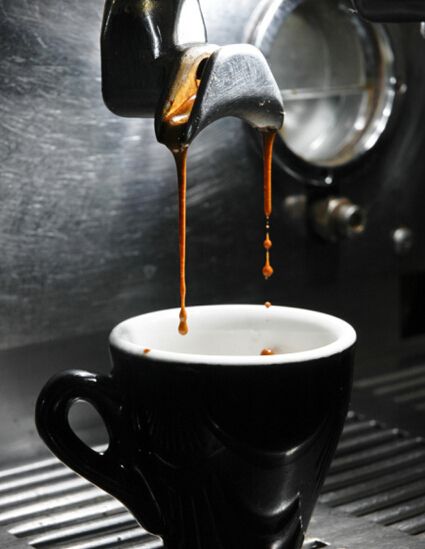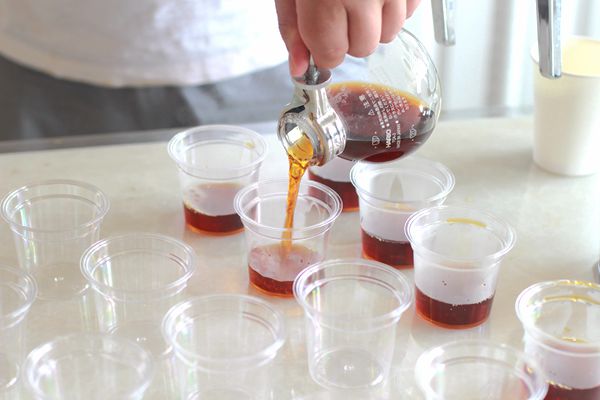Coffee beans roasting knowledge points: basic knowledge about roasting to understand the key points affecting coffee quality
one。 The meaning of baking
1. Definition of baking
The so-called coffee roasting (coffee roasting) refers to the process that through heating the raw beans, a series of physical and chemical reactions take place inside and outside of the coffee beans, and in this process, the sour, bitter, sweet and other flavors of the coffee are formed, forming mellowness and hue, and transforming the raw beans into dark brown beans.
two。 The importance of baking
Among the factors affecting the taste of a cup of coffee, raw beans account for 60%, roasting accounts for 30%, and extraction accounts for 10%. Good roasting can maximize the personality of raw beans and minimize the occurrence of defective flavors. on the contrary, improper roasting will completely destroy good beans. Because it is very difficult to control the heating, time, and temperature in the baking process, baking technology is a very difficult technology, so the importance of baking is more prominent.

two。 The history of baking
As early as the 13th century, Arabs invented to put coffee beans in a pot, heat them and stir-fry them, then grind them into powder, and then brew coffee. The early Arabs liked to bake the beans shallowly and boil them with spices such as cardamom.
Later, this method of stir-frying coffee spread to Syria, Turkey and Egypt, where it was used to stir-fry coffee black, then ground it into powder, boiled it with sugar, and then poured it into a small cup without precipitation and drank it with coffee grounds.
After coffee was introduced into Europe in the 18th century, Europeans also used the Turkish style to stir-fry coffee until black.
Later, because of geographical and cultural differences, Europe was divided into shallow baking schools dominated by Nordic, German, British and Scandinavian countries and deep baking schools dominated by southern Europe. The former usually bake the beans to city--full-city, while the latter generally bake them to the same depth as italy,french.
Accordingly, the North American continent, which was later dominated by immigrants from northern Europe, also followed shallow baking, while Latin America, which was dominated by immigrants from southern Europe, was popular in baking.
Until the mid-19th century, most of Europe used iron pots or ovens to bake beans at home, and later invented a small roaster that uses closed iron buckets instead of iron pans and can be controlled by hand, and can bake a few pounds of beans at the same time. Used by some coffee shops.
With the advent of large baking machines in the mid-19th century, large quantities of baked beans became possible. After continuous innovation after the advent of large roasters, electronically controlled precision machines have appeared in the first half of the 20th century, and machines that can continuously bake 5000kg every hour have been developed.
The emergence of large roasters has changed people's own baking habits. Buying packaged baked beans or coffee powder to cook directly at home facilitates the fast-paced life of modern people. By the 1960s, branded beans dominated the market. But there are also some problems in mass roasting: poor quality raw beans, excessive shallow roasting in order to maintain weight, lack of taste caused by lack of freshness. Since the 1980s, a "boutique coffee movement" was launched in the United States. It advocates people to buy boutique raw beans, family baking, drink fresh coffee, pursue quality and taste, and home roasting begins to be valued again. At the same time, the pursuit of coffee quality also forces some big roasters to adopt higher quality beans to ensure the baking quality.
three。 Development and evolution of roaster
In the early days, people generally used iron pot to stir-fry coffee beans. after coffee was introduced into Europe, Europeans used Turkish iron pot to stir-fry beans, and later invented hand-operated rotary baking, which could bake several pounds of beans at the same time, which was used by some coffee shops.
In the 1860s, large roasters began to come out, and the use of blower to cool the baked beans in 1867 gave birth to the development and innovation of large roasters.
At the end of the 19th century, the advent of hot air roaster greatly improved the speed and efficiency of coffee roasting, making it possible to produce more in large quantities.
In the 20th century, with the combination of roaster and electronic, it was improved to be more precise, and the fully automatic roaster appeared and had more advanced functions.
four。 Common types and main brands of roasters at present
(1) Common types of roasters
1. Hot air type
The hot air type bean dryer uses the blower to absorb the air, and then let the air pass through a heating coil to raise its temperature. Hot air is used as a heating source to bake coffee beans. Hot air can not only provide the temperature needed for baking, but also use the power of airflow to stir coffee beans, killing two birds with one stone.
Advantages: high thermal efficiency, fast heating, relatively uniform heating of raw beans, easy to control.
Disadvantages: because of the high heating efficiency, it is easy to lead to excessive heating, resulting in beans "entrainment", and too high temperature is easy to make the caramelization reaction is not sufficient.
Taste characteristics: the acidity is obvious, the taste is relatively clean and simple, but the taste is not rich enough and lacks depth, and deep baking is easy to produce irritating taste.
2, direct fire type
As the name implies, the direct fire is to heat the coffee beans directly with a flame. Up to now, the "fire" of direct fire not only includes general flame (including gas furnace fire and charcoal fire), but also includes infrared and electric heating pipe.
Advantages: the baking time is long, so the caramelization reaction is sufficient and the flavor is rich.
Disadvantages: it is easy to cause uneven baking, and if the heat is not well controlled, it is also easy to scorch coffee beans and form a scorched bitter taste.
3. Semi-direct fire semi-hot air type
The baking method, which combines the advantages of direct fire and hot air, is the mainstream of commercial baking machines at present. Semi-direct-fire baking is actually similar to direct-fire baking, but because there are no holes in the outer wall of the baking container, the flame will not directly touch the coffee beans. In addition, a ventilation device is added to introduce the hot air from the outside of the baking container into the baking room to improve baking efficiency. Another function of this ventilation device is to suck out the shedding silver skin. Prevent the silver skin from burning because of the high temperature in the baking room and affect the taste of coffee beans.
Semi-direct fire semi-hot air machine has the advantages and disadvantages of both direct fire type and hot air type, but its heating mode is changed according to the adjustment of hot air and boiler speed. The larger the hot air, the faster the speed is, the closer it is to the hot air type; on the contrary, the closer it is to the direct fire type.
(2) main brands of baking machines
1. Probat in Germany
Old brands, large and medium-sized machines, semi-automatic, full-automatic various types, sophisticated design, high price.
two。 Japan fuji-royal
The products of fuji Company of Japan also have good performance, but they are also expensive.
(3) brief introduction of Xiumen roaster
1kg semi-direct fire semi-hot air roaster is a coffee machine produced by Taihuan Company in Korea, although there is still a certain gap between performance and probat, but compared with its more affordable pricing, this machine is still good value for money, it has power heating and gas heating, with uniform heating, high thermal efficiency performance, and its appearance design is also very exquisite amplifier.
Fifth, the reactions and changes in the baking process.
1. Drying: when the raw beans are heated, the water vapor in the raw beans will evaporate, and the green beans will turn white at about 135 degrees Celsius.
two。 dehydration
As the heating goes on, the raw beans change from green to light yellow. When the temperature reaches about 160 degrees, the aroma of baked grain will be emitted. After continuous heating, the beans turn light brown.
3. An explosion
After about 190 degrees dehydration is completed, a burst occurs due to the rupture of the cell wall caused by internal thermal expansion, and a series of thermal decomposition reactions occur inside the beans, in which the caramelization brings the sweetness, dark brown and mellowness of the coffee beans. the explosion lasts about a minute and a half.
4. Second explosion
As the heating goes on, it enters the "second explosion", and a more violent reaction will take place inside the bean. And give off a lot of heat. With the end of the second explosion, the raw bean has basically turned black, the bean body has expanded to 1.5 times that of the original, the surface is oily, and the weight is reduced to 12%, about 20%.
5. Stop it
Usually the baking ends about a minute after the second explosion, when the temperature reaches 230 degrees, which will be a deep French or Italian baking, which may cause the coffee beans to ignite spontaneously when the temperature exceeds 230 degrees Celsius.
six。 Division standard of baking degree
1, roughly divided into four degrees: shallow baking, medium baking, deep baking and heavy baking.
2, each category can be subdivided into two categories, a total of eight categories
Shallow baking:
Light light baking
Medium cinnamon baking
Baking in:
Cinema medium baking
Medium and deep baking in High
Deep baking:
City city baking
Full-city city-wide baking
Re-bake:
Italy Italian baking
French French baking
seven。 The technical difficulty of baking and the baker
Because a variety of small changes in temperature, heat and other small changes in the baking process can change the taste of beans, different beans have different characteristics, and baking is a work of rapid operation in a short time, so bakers are required to master the relevant principles, clearly grasp the characteristics of raw beans, and accurately budget and adjust the baking process in the baking process. In fact, because of the complexity and variability of the baking process, a real baker needs not only theory, but also a lot of experience and perception.
Source:
The blog of the world of coffee with two bottles of water
Important Notice :
前街咖啡 FrontStreet Coffee has moved to new addredd:
FrontStreet Coffee Address: 315,Donghua East Road,GuangZhou
Tel:020 38364473
- Prev

Essentials of espresso knowledge: conditions met by espresso, Italy's national coffee certification body
It is really a shame to learn coffee for two years. I only know that the so-called espresso is a kind of beans roasted with 8g deep. After fine grinding, 90 degrees water is driven by steam to pass through the coffee powder under the pressure of 9 atmospheres. The 30cc extracted in about 25 seconds is a coffee with rich aroma and rich flavor of golden crema. In fact, about esp
- Next

Introduction to coffee quality: SCAA professional coffee cup evaluation system of American boutique coffee association
As one of the most authoritative professional coffee institutions in the world, the professional coffee cup evaluation system established by SCAA is used as a collection of methods, processes and standards for coffee quality evaluation. Although most cafes in China are not suitable to use this method for cup evaluation, some methods and details in the process may be helpful for us to understand the taste of coffee.
Related
- What is the meaning of lactic acid fermentation with coffee bean treatment?
- How to judge the state of foam by sound?
- How does the latte pull out the unicorn pattern? Come to get for a little trick to improve the flower pull!
- Will flower pulling affect the taste of the latte?
- Do you know the history of coffee?
- The difference between honey treatment and sun washing what is raisin honey treatment?
- What kind of milk can a novice use to make coffee foam to keep the foam longer? The correct method and skills of milking tutorial sharing
- Why do washed coffee beans taste sour? Flavor characteristics of washed Coffee
- Introduction to the skill of how to practice the size and height of water injection around the circle of hand-brewed coffee
- How do beginners practice coffee flower drawing from scratch?

